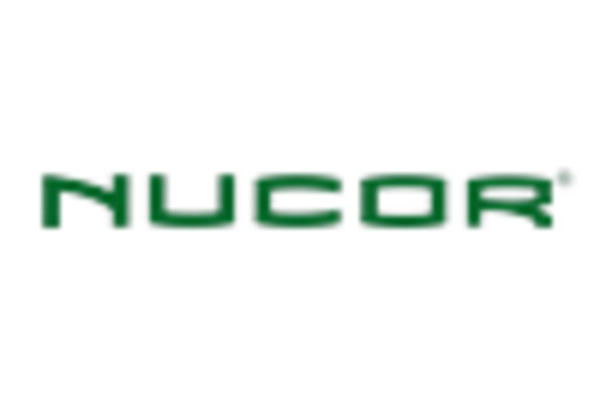The Prefabricated Steel Market is currently characterized by a dynamic competitive landscape, driven by increasing demand for sustainable construction solutions and the need for rapid project delivery. Key players such as Nucor Corporation (US), Steel Dynamics, Inc. (US), and ArcelorMittal (LU) are strategically positioning themselves through innovation and regional expansion. Nucor Corporation (US) has focused on enhancing its production capabilities, while Steel Dynamics, Inc. (US) emphasizes sustainability in its operations. ArcelorMittal (LU) is leveraging its global footprint to optimize supply chains, thereby shaping a competitive environment that prioritizes efficiency and environmental responsibility.
The market structure appears moderately fragmented, with a mix of large multinational corporations and regional players. Key business tactics include localizing manufacturing to reduce transportation costs and optimizing supply chains to enhance responsiveness to market demands. This collective influence of major players fosters a competitive atmosphere where agility and adaptability are paramount, allowing companies to respond effectively to evolving customer needs.
In August 2025, Nucor Corporation (US) announced the opening of a new state-of-the-art steel mill in Texas, aimed at increasing its production capacity and reducing lead times for customers. This strategic move is significant as it not only enhances Nucor's operational efficiency but also positions the company to better serve the growing demand for prefabricated steel in the southern United States, potentially increasing its market share in a competitive region.
In September 2025, Steel Dynamics, Inc. (US) unveiled a partnership with a leading technology firm to integrate advanced AI solutions into its manufacturing processes. This initiative is likely to streamline operations and improve product quality, reflecting a broader trend towards digital transformation in the industry. By adopting cutting-edge technology, Steel Dynamics aims to enhance its competitive edge and respond more effectively to customer demands for precision and sustainability.
In July 2025, ArcelorMittal (LU) launched a new line of eco-friendly prefabricated steel products, which are designed to meet stringent environmental standards. This strategic initiative underscores the company's commitment to sustainability and positions it favorably in a market increasingly driven by environmental considerations. By aligning its product offerings with global sustainability goals, ArcelorMittal is likely to attract environmentally conscious clients and enhance its brand reputation.
As of October 2025, the competitive trends in the Prefabricated Steel Market are increasingly defined by digitalization, sustainability, and the integration of advanced technologies. Strategic alliances are becoming more prevalent, as companies seek to leverage complementary strengths to enhance their market positions. Looking ahead, competitive differentiation is expected to evolve from traditional price-based competition towards a focus on innovation, technological advancement, and supply chain reliability, reflecting the industry's shift towards more sustainable and efficient practices.


















Leave a Comment